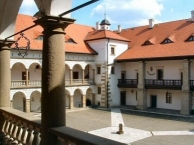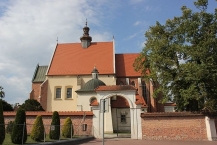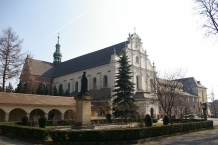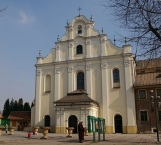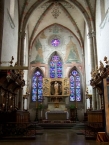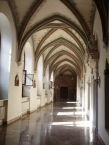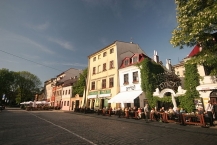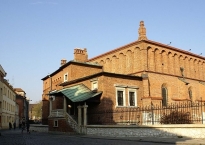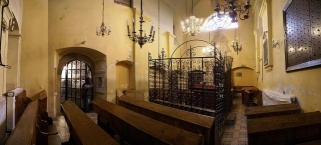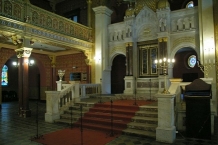Radweg Greenway Bernstein Route
Aktionen
![]()
Bitte warten - Kartendaten werden geladen
Erstellt am 14.05.2013,
zuletzt geändert von biroto-Redaktion am 11.01.2021
Aktionen
Strecken-Merkmale
Gesamtlänge in km
251
Informationen zu Rechten an den GPS-Track-Daten | |
|---|---|
Rechte-Inhaber | OpenStreetMap and Contributors + biroto-Redaktion (biroto.eu) |
Rechte-Ausprägung / Lizenz | Enthält Daten von OpenStreetMap, die hier unter der Open Database License(ODbL) verfügbar gemacht werden |
Link zur Rechtebeschreibung | |
gpx-Datei übernommen aus | |
gpx-Datei hochgeladen | durch biroto-Redaktion am 11.01.2021
|
Gesamtzahl Trackpoints
3.892
Trackpoint-Dichte per km
16
Endorte
Start
Nowy Korczyn, Świętokrzyskie Voivodeship, PL (175 m NHN)
Ziel
District of Námestovo, Region of Žilina, SK (610 m NHN)
Fahrradfreundliche Unterkünfte, Sehenswertes und Infrastruktur
Name u. Anschrift
Breite / Länge
Tel.
Fax.
Mobile
Art d. Unterkunft
Radler-freund-lichkeit
Strecken-km
km zur Strecke
Höhe
87 km
0,0 km
195 m
Informationen zu Urheber-Rechten | |
|---|---|
Rechte-Inhaber | |
Rechte-Ausprägung / Lizenz | cc0: Public Domain keine Rechte vorbehalten |
Link zur Rechtebeschreibung | |
Bild übernommen aus | https://commons.wikimedia.org/wiki/File:Zamek-niepolomice.jpg |
Bild hochgeladen | durch ThimbleU am 30.11.2015
|
Informationen zu Urheber-Rechten | |
|---|---|
Rechte-Inhaber | |
Rechte-Ausprägung / Lizenz | by-sa: CREATIVE COMMONS Namensnennung, Weitergabe unter gleichen Bedingungen |
Link zur Rechtebeschreibung | |
Bild übernommen aus | https://commons.wikimedia.org/wiki/File:Niepolomice_kosciol_10000_Meczennikow_6.jpg |
Bild hochgeladen | durch ThimbleU am 30.11.2015
|
Niepołomice (deutsch: Niepolomitz , Heidenau) ist eine Stadt im südlichen Polen. Sie liegt in der Woiwodschaft Kleinpolen am Ufer der Weichsel 25 km östlich von Krakau
- Zentrum am Rand des Walds von Niepołomice (Puszcza Niepołomicka). Die Stadt besitzt ein unter König Kasimir III. als Jagdschloss erbautes Königsschloss, dessen ursprünglicher Bau im 14. Jahrhundert errichtet wurde.
Sehenswürdigkeiten
Pfarrkirche
Die ab 1349 errichtete gotische, 1696 barock umgestaltete Pfarrkirche unserer Lieben Frauen und der 10000 Märtyrer (Kościół Dziesięciu Tysięcy Męczenników) ist eine später vermutlich unter Einfluss von Tylman van Gameren einschiffig mit Tonnengewölbe umgebaute, ursprünglich zweischiffigen Kirche vom Typ der Kasimirskirchen. Sie besitzt eine Renaissancekapelle der Branicki von Santi Gucci und toskanisch-emilianische polychrome Wandmalerei in der Sakristei aus der Zeit um 1360.
Schloss Niepołomice
Das bestehende Schloss, das dem Typ der regelmäßigen italienischen Paläste entspricht, ist ein in den Jahren 1550 bis 1571 für König Sigismund II. August errichteter Renaissancebau, dessen vier Flügel um einen nahezu quadratischen Innenhof angeordnet sind. Das zweite Obergeschoss wurde um 1800 abgetragen. Drei Flügel werden von 1637 errichteten Arkadengängen gesäumt, die im Erdgeschoss von Pfeilern und im Obergeschoss von Säulen getragen werden. Das von einer Balustrade abgeschlossene Zufahrtstor mit einem Portal aus dem Jahr 1550 liegt in der Achse des Nordflügels.
Rathaus
Beachtenswert ist auch das Rathaus im Stil der volkstümlichen Romantik von Jan Sas-Zubrzycki aus dem Jahr 1903.
Benediktinerinnenabtei Staniątki
Die Benediktinerinnenabtei in Staniątki wurde 1228 gegründet und unter Kaiser Joseph II. im Jahr 1784 in eine Schule umgewandelt.
Informationen zu Urheber-Rechten | |
|---|---|
Rechte-Ausprägung / Lizenz | by-sa: CREATIVE COMMONS Namensnennung, Weitergabe unter gleichen Bedingungen |
Link zur Rechtebeschreibung | |
Text(e) übernommen von: |
Seite „Niepołomice“. In: Wikipedia, Die freie Enzyklopädie. Bearbeitungsstand: 26. Juli 2015, 21:06 UTC. URL: https://de.wikipedia.org/w/index.php?title=Niepo%C5%82omice&oldid=144430791 (Abgerufen: 30. November 2015, 12:45 UTC) |
übernommen / bearbeitet am | 30.11.2015
|
übernommen / bearbeitet durch |
|
108 km
0,1 km
Informationen zu Urheber-Rechten | |
|---|---|
Rechte-Inhaber | |
Rechte-Ausprägung / Lizenz | by-sa: CREATIVE COMMONS Namensnennung, Weitergabe unter gleichen Bedingungen |
Link zur Rechtebeschreibung | |
Bild übernommen aus | https://commons.wikimedia.org/wiki/File:Krakow_Mogila_Opactwo_Cystersow_20080309_1222_2618.jpg |
Bild hochgeladen | durch biroto-Redaktion am 06.12.2015
|
Informationen zu Urheber-Rechten | |
|---|---|
Rechte-Inhaber | |
Rechte-Ausprägung / Lizenz | by-sa: CREATIVE COMMONS Namensnennung, Weitergabe unter gleichen Bedingungen |
Link zur Rechtebeschreibung | |
Bild übernommen aus | https://commons.wikimedia.org/wiki/File:Krakow_Mogila_klasztor_20080309_2608.jpg |
Bild hochgeladen | durch biroto-Redaktion am 06.12.2015
|
Informationen zu Urheber-Rechten | |
|---|---|
Rechte-Inhaber | |
Rechte-Ausprägung / Lizenz | by-sa: CREATIVE COMMONS Namensnennung, Weitergabe unter gleichen Bedingungen |
Link zur Rechtebeschreibung | |
Bild übernommen aus | https://commons.wikimedia.org/wiki/File:Mogiła_-_Klasztor_-_Ołtarz.JPG |
Bild hochgeladen | durch biroto-Redaktion am 06.12.2015
|
Informationen zu Urheber-Rechten | |
|---|---|
Rechte-Inhaber | https://commons.wikimedia.org/w/index.php?title=User:Kanonkrajoznawczy |
Rechte-Ausprägung / Lizenz | by-sa: CREATIVE COMMONS Namensnennung, Weitergabe unter gleichen Bedingungen |
Link zur Rechtebeschreibung | |
Bild übernommen aus | https://commons.wikimedia.org/wiki/File:Klasztor_Mogiła_-_krużganki.JPG |
Bild hochgeladen | durch biroto-Redaktion am 06.12.2015
|
Kloster Mogila (lat. Abbatia Clara Tumba) ist eine Unserer Lieben Frau und dem Heiligen Wenzel geweihte Zisterzienser-Abtei in Polen. Es liegt in der Stadt Krakau (Kraków) im Stadtteil Nowa Huta
.
Kloster Mogila (polnisch Mogiła) wurde im Jahr 1222 durch Bischof Iwan Odrowąż in Kacice nach einer Güterstiftung des Grafen Vislaus gegründet und von seinem Mutterkloster Kloster Leubus (Lubiąż) in Schlesien besiedelt, das wiederum über die Klöster Kloster Kamp, Kloster Walkenried und Kloster Pforta der Filiation der Primarabtei Morimond entstammt. 1225/26 wurde es nach Mogila verlegt. Seit 1953 bildet die Abtei Mogila mit 5 weiteren Klöstern die polnische Zisterzienserkongregation. 1970 wurde die Klosterkirche zur Basilica minor erhoben.
Informationen zu Urheber-Rechten | |
|---|---|
Rechte-Ausprägung / Lizenz | by-sa: CREATIVE COMMONS Namensnennung, Weitergabe unter gleichen Bedingungen |
Link zur Rechtebeschreibung | |
Text(e) übernommen von: |
Seite „Kloster Mogila“. In: Wikipedia, Die freie Enzyklopädie. Bearbeitungsstand: 6. September 2015, 21:02 UTC. URL: https://de.wikipedia.org/w/index.php?title=Kloster_Mogila&oldid=145790594 (Abgerufen: 6. Dezember 2015, 10:10 UTC) |
übernommen / bearbeitet am | 06.12.2015
|
übernommen / bearbeitet durch |
|
118 km
1,7 km
213 m
118 km
0,5 km
202 m
Informationen zu Urheber-Rechten | |
|---|---|
Rechte-Inhaber | |
Rechte-Ausprägung / Lizenz | by-sa: CREATIVE COMMONS Namensnennung, Weitergabe unter gleichen Bedingungen |
Link zur Rechtebeschreibung | |
Bild übernommen aus | https://commons.wikimedia.org/wiki/File:Szeroka,_Kraków,_2009.jpg |
Bild hochgeladen | durch biroto-Redaktion am 31.08.2016
|
Informationen zu Urheber-Rechten | |
|---|---|
Rechte-Inhaber | https://commons.wikimedia.org/w/index.php?title=User:Barbara_Maliszewska |
Rechte-Ausprägung / Lizenz | by-sa: CREATIVE COMMONS Namensnennung, Weitergabe unter gleichen Bedingungen |
Link zur Rechtebeschreibung | |
Bild übernommen aus | https://commons.wikimedia.org/wiki/File:06660vik_Krakowski_Kazimierz._Foto_Barbara_Maliszewska.jpg |
Bild hochgeladen | durch biroto-Redaktion am 31.08.2016
|
Informationen zu Urheber-Rechten | |
|---|---|
Rechte-Inhaber | https://commons.wikimedia.org/w/index.php?title=User:Barbara_Maliszewska |
Rechte-Ausprägung / Lizenz | by-sa: CREATIVE COMMONS Namensnennung, Weitergabe unter gleichen Bedingungen |
Link zur Rechtebeschreibung | |
Bild übernommen aus | |
Bild hochgeladen | durch biroto-Redaktion am 31.08.2016
|
Informationen zu Urheber-Rechten | |
|---|---|
Rechte-Inhaber | |
Rechte-Ausprägung / Lizenz | by-sa: CREATIVE COMMONS Namensnennung, Weitergabe unter gleichen Bedingungen |
Link zur Rechtebeschreibung | |
Bild übernommen aus | https://commons.wikimedia.org/wiki/File:Krakow_Synagoga_Tempel_20071111_1141_2144.jpg |
Bild hochgeladen | durch biroto-Redaktion am 31.08.2016
|
Kazimierz is a part of Old Town district of Krakow ![]() in Poland. Before World War II, it was a Jewish district.
in Poland. Before World War II, it was a Jewish district.
Understand
Kazimierz was a city founded in 1335 by Polish King Casimir III on an island on the Vistula river. In the 19th century the river branch between Kazimierz and Old Town was dried and built over. After the end of 15th century Jews became an important part of Kazimierz' population as they fled Krakow because of antisemitism. The division of Kazimierz is still visible, the western part with pl. Wolnica and St. Michael's Church (Skałka) was Christian and the eastern with pl. Nowy and ul. Szeroka was Jewish.
Kazimierz became one of Krakow's districts in 1791. In 1943 all Krakowian Jews were forced by the Nazi occupiers to move to the ghetto located in Podgórze and later transported to death camps. After the war uninhabited houses in Kazimierz were populated by a poor and sometimes criminal element, so Kazimierz gained the reputation of the 'bad neighbourhood' in Krakow.
In the 1990s, however, a popular annual Jewish Culture Festival started, the city renovated old synagogues, and new cafes, clubs and galleries opened. In the early 21st century, the district underwent a typical gentrification process and these days rents are really high and small galleries and eateries have started to give way to luxurious hotels.
See
Museums and galleries
- Ethnographic Museum, Town Hall building, Plac Wolnica 1, 'Esterka' building, ul. Krakowska 46, ☎ +48 12 430 5575. Located in the old 15th century Kazimierz town hall. 5 - 9 zł, Mondays closed.
- Museum of City Engineering (Muzeum Inżynierii Miejskiej), ul. św. Wawrzyńca 15, ☎ +48 12 421 1242 wew.100. It is located in old tram sheds and on the grounds of former gasworks and powerplant. It has exhibitions on the history of Polish automotive, public transportation, radio and television, household and office appliances industries. The museum is well prepared for younger visitors. 5 - 8 zł, Mondays closed, Tuesdays free.
- Centre for Jewish Culture (Judaica Foundation), ul. Meiselsa 17, ☎ +48 12 430 6449. Exhibitions, concerts, seminars and workshops on Jewish culture. There is also a cafe (with roof terrace!) and a great antiquarian bookshop located in the basement.
- Galicia Jewish Museum, ul. Dajwór 18, ☎ +48 12 421 6842. 10AM-6PM. The Galicja Museum in Kazimierz houses an exhibition of photographs with explanations in Polish and English. These are recent photographs of locations around Poland associated with the Holocaust. Some are places where massacres occurred; most show old synagogues and Jewish cemeteries with comments about how respectfully (or not) these places are now preserved. The museum also has a bookstore and coffee shop and arranges coach trips to Auschwitz. Tickets are 15 zł or 8 zł with a student discount.
- Jewish Community Centre, ul. Miodowa 24, ☎ +48 12 370 5770. Exhibitions, events, lectures on Jewish culture and language lessons.
Synagogues and prayer houses
Before 1939 there were several dozen synagogues in Kazimierz. After the war most of them were destroyed or converted to residential or public use buildings and their previous function is, after remodeling, imperceptible. Some are still functioning as prayer houses or museums:
- ⊙Old Synagogue, ul. Szeroka 24, ☎ +48 12 422 0962. Built sometime during the 15th century, the synagogue is the oldest still standing synagogue in Poland. It was ransacked by the Nazis during World War II and was renovated between 1956 and 1959. Currently, it serves as a museum documenting Jewish life in Kraków. Adults: 8 zł. Discounted: 6 zł.
- ⊙Remuh Synagogue (Synagoga Remuh), ul. Szeroka 40. Su. - F. 9AM - 6PM. The synagogue and adjoining Jewish Cemetery with the grave of Moses Isserles. Adults: 5 zł. Discounted: 2 zł.
- ⊙Tempel Synagogue, ul. Miodowa 24. Built in 1860 - 1862. Reform synagogue that is open to the public. Since it's an operational synagogue male visitors are expected to wear yarmulke and women should dress somewhat conservatively and have their shoulders covered. During the Nazi occupation, the synagogue was used as a horse stable, but was eventually rededicated to its religious mission. Inside, the synagogue is beautiful, it has a monumental example of Aron Kodesh made from Carrara marble and 43 stained glass windows.
- Bne Emuna Synagogue - corner of ul. Meiselsa and pl. Nowy. The building of Judaica Foundation – Centre For Jewish Culture.
- Chewra Thilim Synagogue - corner or ul. Meiselsa and Bożego Ciała. Today an exhibition space with rare, well preserved polychrome.
- Izaak Synagogue (Isaak Jakubowicz Synagogue) - corner of ul. Kupa and Izaaka. Built in 17th century was considered the most beautiful in Krakow, after the war it was a theater, warehouse and sculpture workshop. Since the 1980s it has been renovated and serves as Jewish Education Centre. Since 2007 it had also been used for religious purposes.
- Kowea Itim le-Tora Synagogue - ul. Józefa 42. Built in 1810 and renovated in 1912 (these dates are written in Stars of David put on the facade). Devastated by Nazis the building became residential after the war.
- Kupa Synagogue - ul. Warschauera 8. Also called Hospital or Poor Synagogue as these were the people it mostly served. After the war it was a warehouse and shoe factory, today it is one of the venues for religious ceremonies and cultural festivals, Jewish Culture Festival among others.
- Mizrachi Synagogue - ul. Kupa 18. Built in 1930s right next to Izaak Synagogue. Since the 80s it serves as a Jewish Culture Centre.
- Wolf Popper Synagogue - ul. Szeroka 16. Was one of the most splendid buildings in Kazimierz, devastated during the Nazi occupation. Today a cultural centre with workshops on dance, art classes, lectures, film screenings, etc.
- ⊙High Synagogue - ul. Józefa 38. Called "high" because the prayer room is on the second floor (this is the only example of that kind in Poland). Third synagogue built in Kazimierz, in Renaissance style. It's in bad condition but conservators are working on the building. It is open to public and photo exhibitions are sometimes put there.
- ⊙Great Mikveh - ul. Szeroka 6, building from 1567 rebuilt at the beginning of 20th century, today Klezmer Hois restaurant and rooms. Ritual bath in the basements, around 40 steep stairs below ground level, can be visited.
Churches
- ⊙Bożego Ciała Church (Corpus Cristi Church) — corner of ul. Bożego Ciała and pl. Wolnica. Gothic Church erected by Kazimierz the Great in 1340. The greatest Italian artist of the Renaissance, Bartholomaeo Berrecci, is buried here. The interior is baroque with a marvelous, high baroque altar and maybe the most beautiful baroque stalls in Central Europe.
- ⊙Katarzyny Church (St. Cathrine's Church) corner of ul. Augustiańska and Skałeczna — Gothic Church erected by Kazimierz the Great in 1363 for the Augustinian Order. There is a beautiful baroque altar and the Renaissance grave of bishop Spytek Jordan inside the church.
- ⊙Michala Church (St. Michael's Church). ul. Skałeczna 15. With the monastery of the Paulins, one of the oldest in Poland. The defensive position of the "Church on the Rock" (Skałka) brought settlement already in the 9th century. Bishop St. Stanislaw is said to be killed there by King Boleslaw II in 1079. The garden pond is traditionally believed to have served for pagan sacrifices. Many famous Poles like Jan Długosz, Stanisław Wyspiański, Adam Asnyk, Karol Szymanowski, Józef Ignacy Kraszewski, Jacek Malczewski, and Czesław Miłosz are buried there.
- Church of Holy Trinity (Church of Merciful Hospitalers) - ul. Krakowska 48. Constructed in 1741 by the Trinities friars in late baroque style, according to a project of architect Franciszek Placidi. The interior of the church was ornamented with rococo stucco decorations and illusion style polychrome.
Cemeteries
- Remuh Cemetery, ul. Szeroka 40. Old Jewish cemetery of Kraków. Located next to Remuh Synagogue was established in 1535. It closed when the new cemetery at Miodowa was opened in year 1800. The most notable person buried at Remuh Cemetery is Rabbi Moses Isserles, others include rabbis of the Jewish communities in Vienna, in Prague and in Kraków and heads of Kraków Talmudic Academy. During Nazi occupation the place was destroyed and tombstones reused as paving stones (in Kraków-Płaszów concentration camp). After the war restoration of the cemetery was attempted, but not many tombstones could be found and today only small fraction of the monuments stands again.
- ⊙New Jewish Cemetery, ul. Miodowa 55. Founded in 1800 and operational until around 1920 when it filled. Nazi Germans closed the cemetery and sold the most valuable tombstones to masons for reuse. After the war some of these were returned. Today cemetery has over ten thousand headstones, renovated brick mortuary, lapidarium and a monument dedicated to Holocaust victims. Many notable people are buried here: rabbis, tzadiks, Jagiellonian University professors, writers and painters (Maurycy Gottlieb).
Informationen zu Urheber-Rechten | |
|---|---|
Rechte-Ausprägung / Lizenz | by-sa: CREATIVE COMMONS Namensnennung, Weitergabe unter gleichen Bedingungen |
Link zur Rechtebeschreibung | |
Text(e) übernommen von: |
Wikivoyage contributors, 'Kraków/Kazimierz', Wikivoyage, The FREE worldwide travel guide that anyone can edit, 23 July 2016, 11:04 UTC, <https://en.wikivoyage.org/w/index.php?title=Krak%C3%B3w/Kazimierz&oldid=3025276> [accessed 30 August 2016] |
übernommen / bearbeitet am | 30.08.2016 - 09.09.2016
|
übernommen / bearbeitet durch |
|
119 km
0,4 km
211 m
Öffnungszeiten
in the season
Monday to Sunday 09:00 - 17:00
off season
Monday to Sunday 09:00 - 17:00
Sprachen:
polski
![]()

